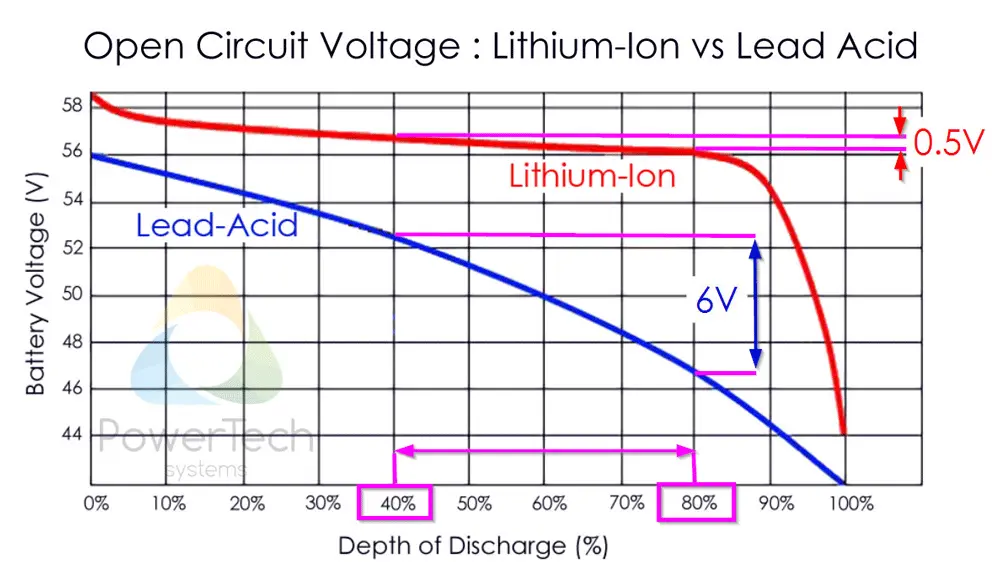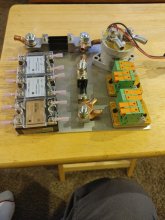Mariner62
New Member
- Joined
- Dec 29, 2020
- Messages
- 84
Happy New Year All,
Thanks for signing me up to the group.
I'm starting a little project to investigate a hybrid Lead Acid/LiFePO4 (LA/LFP) battery bank for my boat. If it works as I hope, I intend to replace the existing 24V/600AH AGM battery bank on my boat with a 24V/560Ah LFP + 24V/110Ah LA bank, but before I get to that I'm going to build and test a "scale model" test system comprising 12V/280Ah LFP + 60Ah LA. A couple of diagrams are attached of the test system and the eventual boat installation.
I have some specific reasons for wanting a hybrid installation, so I don't really want to discuss the "why hybrid" question (unless someone is really interested in that). However, I'm interested in any feedback on the operation of the system, especially things I can investigate through the testing process.
The test system uses 4xEve 280Ah cells, REC Active BMS with shunt and contactor as the LFP component, and a 60Ah AGM with its own Victron Smart Shunt. I also have a Victron 12V/500W Multiplus Invertor and a Cerbo GX for testing.
I ordered the EVE 280Ah cells from China via Amazon some weeks ago and they arrived into Sydney (home) within a couple of weeks, but have now been stuck for almost the same time in the local courier delivery company, Aramex/Fastway, who are just hopeless. Fingers crossed they arrive soon and I can get onto balancing them and building the LFP battery.
One dilemma I have at the moment is how to configure the changeover between Lead Acid (LA) and LFP.
I could configure the LFP isolator to open immediately upon say 90-95% charge of the LFP bank, and configure the system chargers for a Lead Acid profile (with LFP max voltages observed). That way the LA batteries get charged fully every time the system comes to 100%, and operate in float until charging sources dwindle. Then I need a reliable way to bring the LFP battery back online to take the load.
Another approach would be to keep the LA battery in reserve for the majority of the time and manage the charging sources to turn them off when the LFP reaches 90-95%, then the LFP immediately starts to discharge again. Maybe bring the charge sources back at 85% or something like that? This is a more complicated interconnection problem, but certainly doable. In this mode of operation the LA battery never really attains a full charge in normal life, but is never really discharged either. It is just always there to take the load in emergency if (when?) the LFP flips out, or when needed on-line as a long term float when the boat is in storage.
Anyway, that's the plans right now. I'm really interested to hear about any experiences playing with directly connected hybrid systems like in the attached diagrams.
Cheers all
Thanks for signing me up to the group.
I'm starting a little project to investigate a hybrid Lead Acid/LiFePO4 (LA/LFP) battery bank for my boat. If it works as I hope, I intend to replace the existing 24V/600AH AGM battery bank on my boat with a 24V/560Ah LFP + 24V/110Ah LA bank, but before I get to that I'm going to build and test a "scale model" test system comprising 12V/280Ah LFP + 60Ah LA. A couple of diagrams are attached of the test system and the eventual boat installation.
I have some specific reasons for wanting a hybrid installation, so I don't really want to discuss the "why hybrid" question (unless someone is really interested in that). However, I'm interested in any feedback on the operation of the system, especially things I can investigate through the testing process.
The test system uses 4xEve 280Ah cells, REC Active BMS with shunt and contactor as the LFP component, and a 60Ah AGM with its own Victron Smart Shunt. I also have a Victron 12V/500W Multiplus Invertor and a Cerbo GX for testing.
I ordered the EVE 280Ah cells from China via Amazon some weeks ago and they arrived into Sydney (home) within a couple of weeks, but have now been stuck for almost the same time in the local courier delivery company, Aramex/Fastway, who are just hopeless. Fingers crossed they arrive soon and I can get onto balancing them and building the LFP battery.
One dilemma I have at the moment is how to configure the changeover between Lead Acid (LA) and LFP.
I could configure the LFP isolator to open immediately upon say 90-95% charge of the LFP bank, and configure the system chargers for a Lead Acid profile (with LFP max voltages observed). That way the LA batteries get charged fully every time the system comes to 100%, and operate in float until charging sources dwindle. Then I need a reliable way to bring the LFP battery back online to take the load.
Another approach would be to keep the LA battery in reserve for the majority of the time and manage the charging sources to turn them off when the LFP reaches 90-95%, then the LFP immediately starts to discharge again. Maybe bring the charge sources back at 85% or something like that? This is a more complicated interconnection problem, but certainly doable. In this mode of operation the LA battery never really attains a full charge in normal life, but is never really discharged either. It is just always there to take the load in emergency if (when?) the LFP flips out, or when needed on-line as a long term float when the boat is in storage.
Anyway, that's the plans right now. I'm really interested to hear about any experiences playing with directly connected hybrid systems like in the attached diagrams.
Cheers all
Attachments
Last edited:






